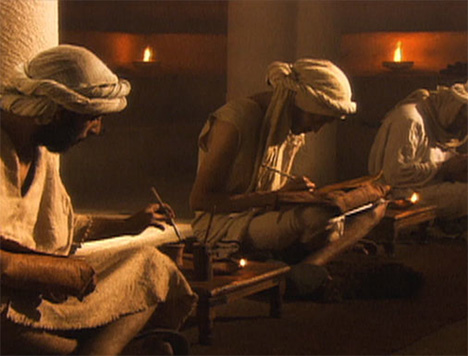The Function of Texts in an Oral Culture

Some excerpts from Ben Witherington’s long summary of William A. Johnson’s short book, Readers and Reading Culture in the High Roman Empire:
Let me be clear that this book focuses on people like Pliny or Aulus Gellius or Galen, or Fronto or Lucian, but there is much to be learned from this book that can be applied, mutatis mutandis to literate Christians, their scribes, and early Christian communities of reading and writing…
Bookrolls were generally the product of scribes, not of private persons. “Making a bookroll involved no more than taking a premanufactured papyrus roll, writing out the text, attaching additional fresh rolls as the length of the text required, and when finished, cutting off the blank remainder.” (p. 18). Or not. It is entirely possible that what happened with Mark’s Gospel is that the original ending of only a few verses about seeing the risen Jesus after Mk. 16.8 was lost, since the outermost edge of the end of the text was left exposed to the elements (no they didn’t heed the exhortation—be kind and rewind, that we used to hear during the videotape era), so more papyrus was added to the end, and the result was the production of no less than three alternative endings, including the so called long ending of Mk. 16.9ff. (of course here in Kentucky it can only be seen as bad news that Mk. 16.9ff is not an original part of Mark’s Gospel since it provides the only possible endorsement of snake handling and poision drinking as tests of faith)…
Johnson describes the bookroll as an icon of elitism (p. 26), and he is right about this. And texts required not only scribes but lectors, those who could read the text fluently. Sometimes slaves served as lectors, but this was a different function from being a scribe, and a still different function from being a scholar. In part because texts were rare and precious and expensive, and written in scriptum continuum or as Johnson calls it scriptio continua, training children to read focused on their memorizing Greek and Latin syllables, not merely letters. That way when they looked at a continuous flow of letters their minds were condition to see at least syllables if not words in the maze of letters.
And though it comes as something of a surprise to us, the function of becoming literate was not so one could read silently for one’s own benefit, but so one could become part of a community of readers who read to each other out loud and as Quintilian urges the goal is to become an orator, a rhetor, and so eloquent. “Reading out loud is intimately tied up with learning the phrasing– for everyone, not just budding orators– and phrasing is naturally linked with accurate apprehension of the meaning of the text.” (p. 29). Quintilian himself says “As regards reading, it is only possible to show in actual practice such things as knowing when to take a breath, where to place a pause in a line, where a new sentences ends of begins, when the voice ought to be raised or lowered, what inflection should be used with each phrase, and what should be spoken more quickly or more slowly….[In order to do all this] “he must [already] understand” the text (Inst. Or. 1.8.1-2).
Exactly, and so the notion that Paul would just send letters off to be deciphered afresh by bewildered semi-literate converts is a nonsense. This is not how ancient literary texts were normally treated. To the contrary, it is far more likely that Paul had someone take the text his scribe had written, already knowing its contents, and then orally deliver the text at the destination, with full ability to comment on and explain the text. Otherwise, it was just a bewildering maze of letters that could be parsed in various ways. Texts in an oral culture do not function like texts in our world.
Texts that are worthwhile or important would not merely be read out once, but repeatedly read, repeatedly digested, and in part would be memorized, and the first person to do this would be the lector, tasked with delivering the text orally at the destination. Notice for example the distinction made between ‘the reader’ (singular) in Rev. 1.3 and the hearers (plural) to whom he would speak. The reader is not the audience! The reader is the emissary of John of Patmos, sent to orally deliver his apocalypse not just once, but to seven different churches. That’s a lot of reading. What is striking about early Christianity is the sheer volume of texts, some of which bear the marks of eloquence in Greek. The social world of early Christianity involved learning circles, some literate leaders or readers, and their texts were oral texts…
A text had to be popular enough, copied enough, circulated enough to inspire the desire to emulate, imitate, and in general rip off. Producing texts was an expensive business, and furthermore, there was a whole ethical code involved in the literate production of texts. The ancients who were well trained could smell a forgery a mile off…
It is unlikely in the extreme that there was any sufficient interest in the first century A.D. when Christianity was just emerging to create forged texts attributed to a Paul or a Peter or others. The Christian community was small, its social networks were tight, and the usual motive for forgery was to make money. Thus, while it is not impossible there were some ancient forgers of Christian documents in say the second century and later (in fact we know there were some), the social, and economic, and indeed the moral setting of earliest Christianity, makes this an unlikely hypothesis if applied to the canonical texts.

























